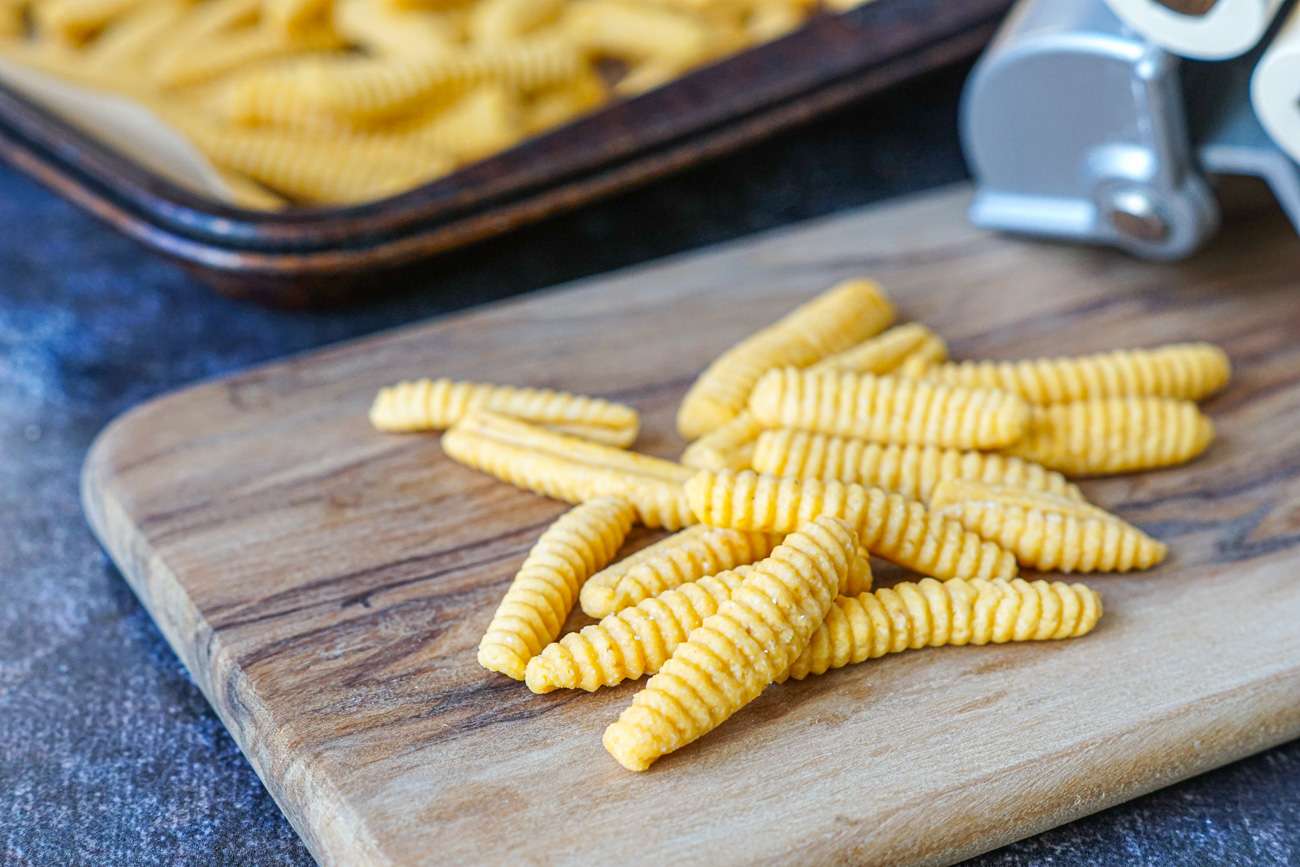
0.0 from 0 votes
Butternut Squash Cavatelli
A recipe for Butternut Squash Cavatelli! Blended butternut squash is combined with semolina and water to create a smooth dough, then shaped into cavatelli.
Prep Time
40 mins
Cook Time
1 hr 40 mins
Additional Time
1 hr
Total Time
2 hrs 55 mins
Servings: 4 Servings
Course:
Main Course
Cuisine:
International
Ingredients
- 1/2 medium (about 515 grams/ 1 pound 2 ounces) butternut squash halved and seeded
- 500 grams (1 pound 1 2/3 ounces) semolina
- 70 grams ( 2 1/2 ounces) water
Instructions
- Preheat oven to 400˚F (200˚C, or gas mark 6).
- Bake the squash cut-side down on a baking sheet for 30 minutes.
- Flip the squash and bake until tender to the center when tested with a paring knife, about 45 minutes. Let cool.
- When the squash is cool enough to handle, scoop the flesh out of the skin and purée it using a ricer or food mill. Let cool to room temperature.
- Use 240 grams (8 1/2 ounces) of the squash purée to mix the dough. Reserve the remaining squash purée for another use.
Cup of Yum
To form the pasta dough:
- Place the semolina in a large bowl or on a wooden board and make a well in the center.
- Place the pureed butternut squash and water in the well, then bring the dough together using a fork.
- The amount of flour needed may vary slightly depending on the brand of the flour and the humidity. Keep in mind that it's much easier to add flour to a wet dough than it is to add liquid to a dry dough, so you can hold back a bit of the flour at first and then add more if the dough feels sticky. You're after a firm dough that's just barely sticky. A bit of tension between the machine and the dough is what causes the dough to curl up into cavatelli.
- Knead the dough until it is smooth and elastic, about 10 minutes. Kneading will be a little bit of a workout. If you or the dough need a break, by which I mean the dough feels resistant to kneading or seems to be tearing, wrap the dough in plastic wrap or cover with an inverted bowl and let rest for a few minutes. Kneading should be much easier once you come back to it. The dough is ready when it springs back readily when poked. If there are any dry bits of dough on the kneading surface, take care to avoid working them into the dough.
- Wrap the dough tightly in plastic wrap to keep it from drying out. Let the dough rest at room temperature for at least an hour and preferably two. The resting time allows the flour to fully hydrate.
- At this point you can refrigerate the wrapped pasta dough for 24 to 48 hours. Bring refrigerated pasta dough to room temperature before shaping.
To shape the cavatelli:
- Work quickly to prevent the pasta from drying out. Do not use dusting flour. Cut the dough in half and rewrap 1 portion to keep it from drying out.
- Using a rolling pin, roll the other portion of dough to a thickness of just under 1/2 inch (1 centimeter).
- Cut the dough into strips that are all the same width and somewhat narrower than the rollers of the machine, 3/4 inch (2 centimeters) wide is a pretty good size.
- Pass each strip of dough through the machine, cranking the handle slowly to form the cavatelli. Make more cavatelli with the remaining portion of dough in the same manner.
- The size of the cavatelli will vary depending on the width of the strips of dough.
- Scraps and misshapen cavatelli, which happen from time to time, can be kneaded together and then formed again.
- Try to make all of the cavatelli within each batch the same thickness and size so that they cook evenly.
- Arrange cavatelli as they are made in a single layer on pasta screens or flour sack towel-lined baking trays.
- Cavatelli may be cooked immediately or left at room temperature like this for up to several hours. To keep cavatelli that's made in the morning moist until dinnertime, keep it covered with flour sack towels on a flour sack towel-lined pasta screens or baking trays.